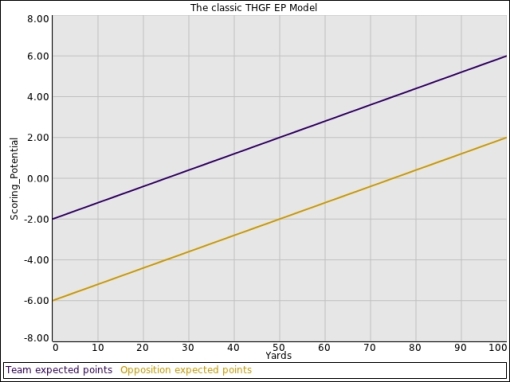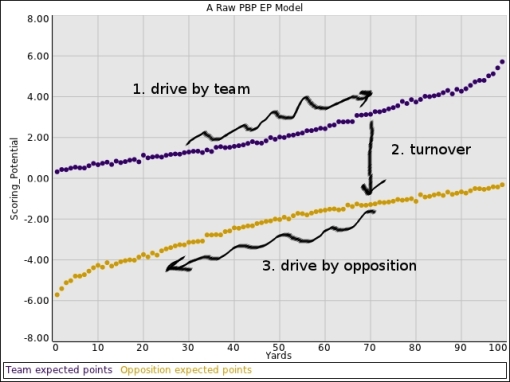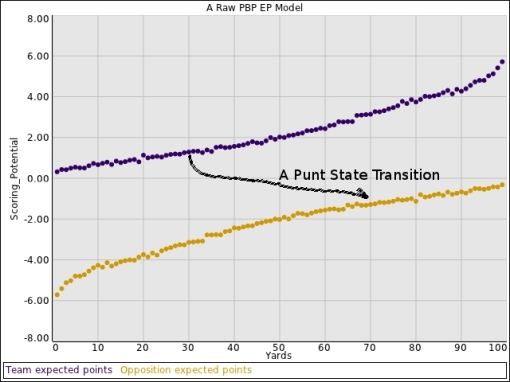In chemistry, people will speak of the chemical potential of a reaction. That a mix of chemicals has a potential doesn’t mean the reaction will happen. There is an activation energy that prevents it. To note, the reaction energy can’t exceed the chemical potential of a reaction. Energy is conserved, and can neither be created nor destroyed.
Likewise, common models of the value of yardage assign a scoring potential to yards. I know of 5 models offhand, of which the simplest is the linear model (one discussed in The Hidden Game of Football). We’re going to derive this model by argument from first principles. There is also Keith Goldner’s Markov Chain model (see here and here), David Romer’s quadratic spline model (see here or just search for “David Romer football” via a good Internet search engine), the linear model of Football Outsiders in 2003, and Brian Burke’s expected points analysis (see here, here, here, and here). And just as in thermodynamics, where energy is conserved, this scoring potential has to be a conserved quantity, else the logic of the model falls apart.

One of the points of talking about the linear model is that is applies to all levels of football, not just the pros. Second, since it doesn’t require people to break down years worth of play by play data to understand it, the logic is useful as a first approximation. Third, I suspect some clever math geek could derive all the other models as Taylor series expansions where the first term in the Taylor series is the linear model itself. At one level, it has to be regarded as the foundation of all the scoring potential models.
Deriving the linear model.
If I start at the one yard line and then proceed back into my own end zone and get tackled, I’ve just lost 2 points. This is true regardless of the level of football being played. If instead I run 99 yards to my opponent’s end zone, I score 6 points instead. That means the scale of value in the common linear model is 8 points, and if we count each yard as equal in scoring potential, we start at -2 yards in my end zone, 6 in my opponents, and every 12.5 yards on the field, I gain 1 point of value. I do not have to crunch any numbers to assume this model as a first approximation.
Other models derive from analyzing a large data set of games for down, distance, to go, and time situations. They can follow all the consequences of being in those down/distance combinations and then derive real probabilities of scoring. We’re going to call those model EP, EPA or NEP models. The value in these models is rather than assuming some probability of scoring, average scoring probabilities are built into the model itself.
What’s the value of a turnover?
In the classic linear model, as explained by The Hidden Game of Football, the cost of a turnover is 4 points. This is because the difference in value between both teams everywhere is 4 points. The moment the model becomes nonlinear, that no longer applies. Both Keith Goldner’s model and the FO model predict that a turnover at the line of scrimmage minimizes in the middle of the field and maximize at the ends.
4 points is worth 50 yards. We’ll come back to that in a bit.
What’s the value of a possession?
It’s the value of not turning the ball over, and since we know the value of a turnover, in the linear model, possession is worth 4 points. In other models, this may change.
The value of the possession in the linear model is always 4 points, even at the end of the game. To explain, there are two kinds of models that predict two kinds of things.
scoring potential models predict scoring
win probability models predict winning
The scoring potential of the possession does not change as the game is ending. The winning potential does change and should change markedly as the game begins to end.
How much is a down worth?
This is an important issue and not readily studied without a data heavy model. I’d suggest following a couple of the Brian Burke links above, they shed a terrific amount of light on the topic. Essentially, the value of a down at a particular time and distance is the difference in expected points at that time and distance between those downs.
How much is a touchdown worth?
We’ll start with the expected points models, because it becomes easy to see how they work. EPA or NEP style models have a total assigned value for the score (6.4 pts Romer, 6.3 Burke), so the value of scoring a touchdown is the value of the score minus the value of the position on the field. It has to be that way because the remaining value is a function of field position et al. If this isn’t true, you violate conservation of a scoring potential.
Likewise, in the linear model, the value of the touchdown is equivalent, due to linearity and scoring potential conservation, to the yards required to score the touchdown. This means if the defense recovers the ball on the opponent’s 5 (i.e. the defense has just handed you 95 yards of value), and your team runs for 3 yards, and then passes 2 yards for the score, that the value of the touchdown is 2 yards, or 0.16 points, and the value of the entire drive is 5 yards.
In this context, the classic interpretation of what THGF calls the new rating system doesn’t make a lot of sense.
RANKING = ( yards + 10*TDs – 45*Ints)/attempts
I say so because the yards already encompass the value of the touchdown(s). In this context, the second term could be regarded as an approximation of the value of the extra point (0.8 points of value in this case). And 45 instead of 50 is an estimation that the average INT changes field position by about 5 yards.
Finally, this analysis begs the question of what model Pro Football Reference’s adjusted yards per attempt actually describes. I’ll try, however. If you adjust the value of yards to create a “barrier potential” term to describe the touchdown, you get the following bit of algebra
0.2(x + 2) + (x + 2 ) = value of true scoring difference = 6.4 + 2 = 8.4
1.2x + 2.4 = 8.4
1.2x = 6.0
x = 5
So, if you adjust the slope so the value of the line at 100 equals 5 instead of 6, then the average value of a yard becomes 0.07 points, and the cost of a turnover then becomes 3 points, or about 43 yards.
How much is a field goal worth?
The same logic that applies for a touchdown also applies for a field goal. It’s the value of the score minus the value of the particular field position, down, etc from which the goal is scored. Note that in a linear model, the value is actually negative for a field goal scored from the 37.5 yard line in. And this actually makes sense, because the sum of the score values, as the number of scores grow large, in a well balanced EPA/NEP model should approach zero. In the linear model, I suspect it will approach some nonzero number, which would be an approximation of the average deviation from best fit EPA/NEP function itself.
Okay, so what if high scoring teams have this zero scoring value? What’s going on?
This is the numerator of a rate term, akin to that of a shooting percentage in the NBA. But since EP models are already averaged, the proper analogy is to the shooting percentage minus the league average shooting percentage. And to continue the analogy a bit further, to score in the NBA, you not only need to shoot (not necessary a good percentage), but you also need to make your own shot. Teams that put themselves into position to score are the equivalent, they make their own shot. I’ll also note this +/- value probably also is a representation of the TD to FG ratio.
Conclusion
Scoring potential models are part of the new wave of football analysis and the granddaddy of all scoring potential models is the linear model discussed extensively in The Hidden Game of Football. In these models, scoring potential is a conserved quantity and can neither be created nor destroyed. Some of the consequences of this conservation are discussed above.















